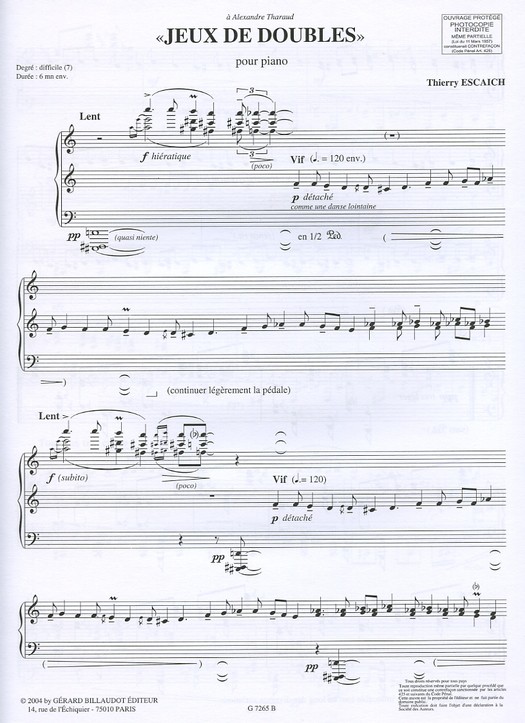
Happy Present Meet
Escaich Jeux de Doubles for Piano Solo
Doubles games
Total duration 00:06:00
BOUTHINON-DUMAS Brigitte
Cycle/Level Difficulty (cycle 3)
Composed from the first measures of the Gavotte theme and Six Doubles by Jean-Philippe Rameau, Jeux de doubles presents itself as a stained glass window in which the reminiscences of Rameau's theme take on the most diverse appearances – both at the harmonic and rhythmic level. than in the spatial arrangement – as in a series of short variations linked to each other. The idea of the double appears in the play of false symmetries which governs, for example the sequence of rhythmic frames, or the idea of stylistic duality when we fleetingly glimpse scraps of baroque sentences dialoguing with their own polymodal transformation in a game of distorting mirrors.
This same idea of the double is still found in the spatial division of the keyboard into two distinct planes, which most often leads to a superposition of two different musics, or two types of opposing developments. Everything finally takes place in a sort of dance that is both frenetic and jubilant, dotted with brutal eruptions of opposing climates: a dance to which a constantly renewed writing of irregular rhythms gives the character of a playful toccata. It was Alexandre Tharaud who created the piece alternating with Rameau's suite.
(Thierry Escaich)
Gavotte 테마의 첫 소절과 Jean-Philippe Rameau의 Six Doubles로 구성된 Jeux de doubles는 라모의 테마에 대한 회상이 조화와 리듬 수준 모두에서 가장 다양한 모습을 보이는 스테인드 글라스 창으로 나타납니다. 공간 배열보다 – 서로 연결된 일련의 짧은 변형처럼. 이중의 개념은 예를 들어 리듬 프레임의 순서를 지배하는 거짓 대칭의 플레이에서 나타나거나, 게임에서 자체적인 다중 모드 변환으로 대화하는 바로크 문장의 스크랩을 잠깐 엿볼 때 문체 이중성의 아이디어가 나타납니다. 왜곡된 거울.
이중에 대한 이와 동일한 아이디어는 건반을 두 개의 별개의 평면으로 공간적으로 분할하는 데에도 여전히 발견되며, 이는 가장 흔히 두 개의 서로 다른 음악 또는 두 가지 유형의 반대되는 전개의 중첩으로 이어집니다. 마침내 모든 것은 서로 반대되는 기후의 잔혹한 분출로 점철된 열광적이면서도 환희에 찬 일종의 춤으로 이루어집니다. 이 춤에는 끊임없이 새로워지는 불규칙한 리듬의 작곡이 장난스러운 토카타의 성격을 부여합니다. 라모의 모음곡과 교대로 이 작품을 만든 사람은 알렉상드르 타로(Alexandre Tharaud)였습니다.
(티에리 에스카이치)
편곡자 Bouthinon-Dumas, Brigitte
작곡가 Escaich, Thierry
